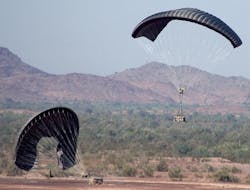Army places order for 100 GPS- and computer-controlled parachute cargo delivery systems
Officials of the Army Contracting Command at Natick, Mass., awarded a $30 million contract to Airborne systems to provide 110 Joint Precision Airdrop Systems (JPADS), which uses GPS, steerable parachutes, and an onboard computer to steer air-dropped cargo loads from high altitudes to designated spots in drop zones with accuracy of 250 feet.
JPADS uses Global Positioning System (GPS) satellite navigation signals to fly itself from high altitudes to its designated landing point on the ground. Its gliding ram-air parachute enables it to land far from where it was released.
The JPADS guidance system enables Army and Air Force air-replenishment experts to make precision high-altitude air drops to one or several locations at one time.
Related: CASSIDIAN's ram-air cargo parachute system ParaLander receives operational certification
JPADS integrates the Army's Precision and Extended Glide Airdrop System (PEGASYS) and the Air Force's Precision Airdrop System (PADS) program. The Army operates several precision airdrop systems, ranging from extra light to heavy payloads.
The Air Force PADS component of JPADS operates on a rugged laptop computer that computes release points for non-steerable parachute air-drop bundles by factoring in weather, wind, altitude, air pressure, and temperature. It also can receive weather updates and en-route mission changes through satellite links.
Army officials ordered the JPADS system with 10,000-pound capacity, which Airborne Systems calls the DragonFly guided precision aerial delivery system. The DragonFly is an autonomous GPS-guided cargo delivery system with elliptical ram air parachute canopy.
The DragonFly's on-board computer uses the desired impact point to calculate its position four times per second and continually adjusts its flight algorithm for accuracy, Airborne Systems officials say.
Related: Thales GPS Receivers Help Study Airdrops of Cargo
The DragonFly's airborne systems mission planner, which is compatible with the JPADS Mission Planner, also can run simulated missions in virtual operational environments when using terrain-mapping software.
Airborne Systems offers a family of guided precision aerial delivery systems that includes the MicroFly and FireFly, in addition to the DragonFly. These parachute cargo-delivery systems can land payloads that weigh between 100 and 10,000 pounds. The company is developing the MegaFly and the GigaFly systems that will increase payload weight to more than 40,000 pounds.
All systems operate with a common algorithm, user interface, and mission planner.
For more information contact Airborne Systems North America online at www.airborne-sys.com, or the Army Contracting Command-Natick at www3.natick.army.mil.
